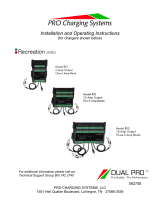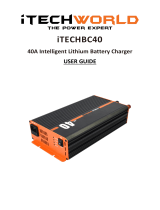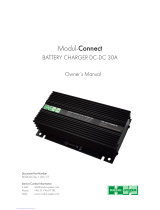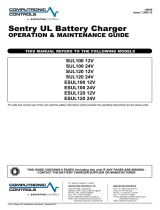
14 | SAMLEX AMERICA INC.
5.2.3 Connecting The Batteries or Other DC Loads
The output has a common Negative (-) terminal (5 in Figs 2.1 to 2.3) and 3 Positive
terminals (6, 7 and 8 in Figs 2.1 to 2.3) for charging up to 3 independent banks of
batteries. Each Positive connector has it's own internal isolating diode which works as a
battery isolator. If more than one bank of batteries is connected, these will be charged
at the same time as long as the AC power is available to the charger (the maximum
charging current of 15 A of SEC-1215UL / SEC-2415UL and 30 A of SEC-1230UL will be
shared among the connected banks of the batteries depending upon their discharged
states). In case the AC power fails or if there is no output from the charger, the isolating
diodes will prevent charging / discharging among the batteries connected to the banks.
The above arrangement works as a battery isolator and can divide the charging current
into a maximum of 3 isolated branches and allows current ow in each branch in one
direction only. If more than one battery systems are being used independently, the system
batteries will discharge to different levels. If system batteries are connected in parallel
to charge from a single charger, a weak or a dead battery will drain the charge from the
strong battery. Such situation occurs in RVs, boats and other vehicles where 2 separate
battery systems are used – starter battery for starting and running the engine and the
other auxiliary / house battery system for running auxiliary devices like inverters, refrigera-
tors, car stereos etc. Here, the starter battery should be connected to one bank and the
auxiliary / house battery to the second bank. Fig. 5.1 shows this connection.
In a single battery bank, two or more batteries may be connected in parallel to increase
their Ampere Hour (Ah) capacity. These will be discharged and charged as a single battery
bank. In this case, the paralleled bank of multiple batteries is to be considered as a single
bank and connected to any one of the 3 banks of the charger as shown in Fig. 5.2 for bank
of 4 batteries. For proper charging of all the batteries, please ensure that the Positive wire
“A” from the charger is connected to the Positive terminal of the rst battery (Battery 1)
and the Negative wire “B” is connected to the Negative terminal of the last battery (Bat-
tery 4). This will ensure the following:
• Resistance of the interconnecting cables will be balanced and the individual batteries
will see the same series resistance
• All the individual batteries will be charged at the same charging current and thus, will
be charged to the same state of charge
• None of the batteries will see an overcharge condition
When connecting a single battery or other single DC load, it can be connected to the com-
mon Negative and any one of the 3 Positive terminals as in Fig. 5.2.
5.3 OPERATION
When the charger is switched on, the Red LED marked "Power" (2 in Figs 2.1 to 2.3)
lights up indicating that output voltage is available. When the batteries are being
charged or when the charger is supplying other DC load, the current fed by the charger
will be indicated by the Ammeter (1, Figs 2.1 to 2.3).
SECTION 5 | Installation & Charger Operation

























